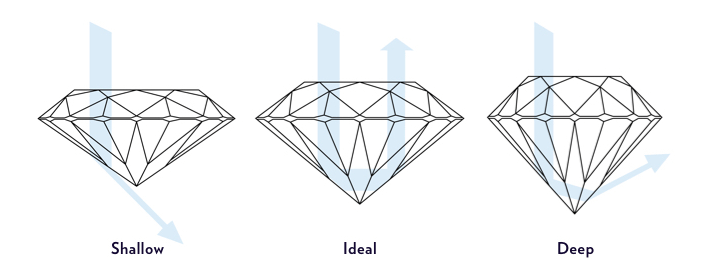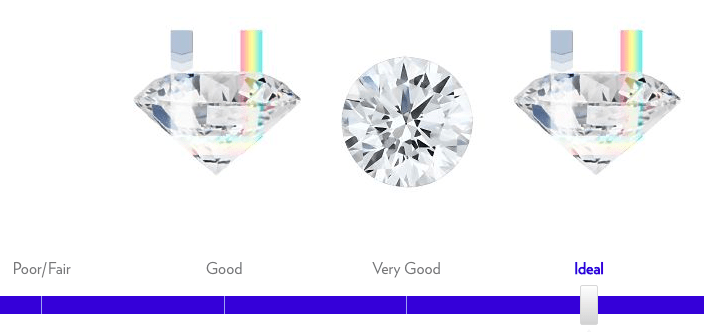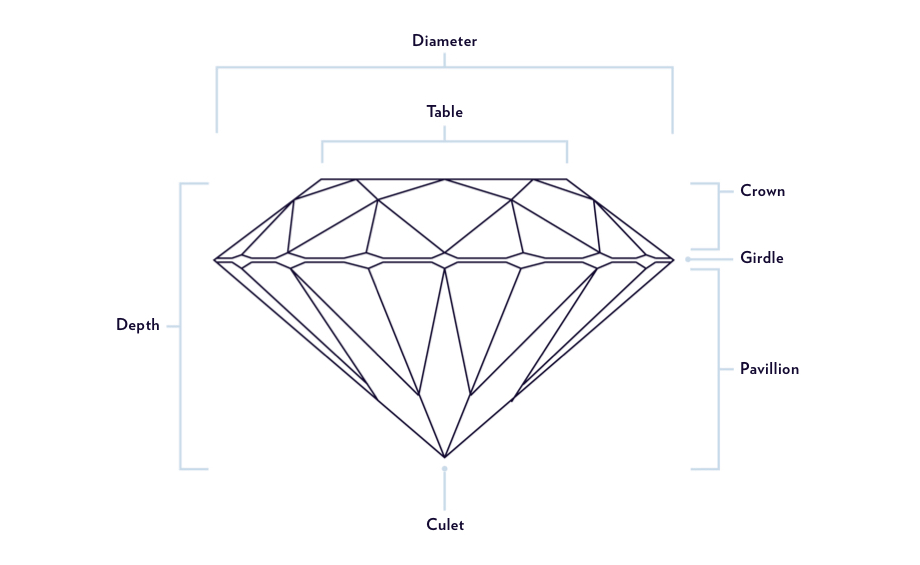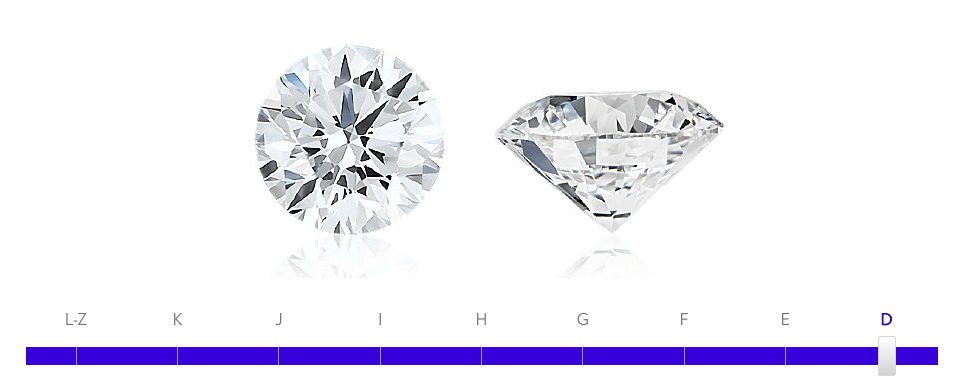Know your diamond
Diamond Education
At BUX Diamantaire we aspire to maintain one of the best collections of finest cut diamonds. The goal is to give our customers a wide range of options to choose from to bring a perfect match between the budget and their dream jewelry. But we understand that sometimes it might get daunting to choose the perfect piece of diamond from a bunch of options. The best solution we could come up with is to let you know about the characteristics of your desired diamond, the types, what factors affect the prices, how you should choose and so on. We tried to take you through a short tour below to update you on how diamonds work.
The most important features to look for when choosing a diamond can be defined through one single terminology- “The 4Cs of Diamonds”. The 4Cs consist of cut, color, clarity, and carat weight. These features are measured on a standardized grading scale and each diamond comes with a grading certification from independent diamond grading labs.
THE CUT
The Cut Of A Diamond
The cut of a diamond is the most important feature among the 4Cs because the most beautiful thing about a diamond, the sparkle, depends largely on the cut. A diamond has a numerous number of surfaces. The cut of a diamond defines how well these surfaces are aligned and well-proportioned the dimensions are to achieve the best sparkle. Small things like, a diamond’s diameter to depth ratio are crucial in influencing the price and beauty of a diamond.
THE BEST
The Best Cut
There is no such thing called the “Perfect Diamond”. Everyone wants the best sparkle they can get from their purchase, whether it be a 1 or 16 carat diamond. The cut is so crucial because even the clearest and flawless diamond can look gloomy if the cut is too deep or shallow. So as it is a continuous effort from the diamantaires and depends on expertise, the cut of a diamond is largely influenced by the budget. So, when choosing the diamond, it is advised to get the best cut grade affordable.

CUT GRADES
Different Cut Grades
The IDEAL cut is the most reflecting cut representing the top 3% of cut qualities. Diamonds in this grade are low absorbents and reflect away most of the light entering through the surface of the diamond.
The VERY GOOD grade also represents high reflecting diamonds; not as much as the ideal grade but close with a lower price range. This cut grade depicts the top 15% quality diamonds.
The GOOD cut represents the top 25% with reflection rates lower than VERY GOOD and significantly lower than the IDEAL grade.

The Characteristics
Characteristics of A Well-Cut Diamond
Superior Brilliance – refers to the white light reflection capabilities of a diamond.
Fire – represents light entering the diamond surface reflecting in the colors of the rainbow.
Scintillation – refers to the sparkle created through the change of contrast between dark and light areas.
The Anatomy
The Anatomy of A Diamond

The structure of a diamond can be categorized into various sections. The term “Table” represents the largest facet of a gemstone. “Crown” represents the portion extending from the girdle to the table; basically the top portion of a diamond. The “Girdle” refers to the circumference of a diamond. It is the intersection of the crown and the pavilion. “Diameter” is basically the measurement from one girdle edge of a diamond straight across to the opposing side. The “Pavilion” refers to the portion extending from the girdle to the culet. It represents the bottom part of a diamond. The “Culet” is the facet at the tip of a gemstone. Generally, the preference is that the culet will be graded none or small meaning, not visible to the naked eye. The “Depth” is the height of a gemstone measured from the culet to the table.
Difference
Cut vs. Shape
Although the two terms might seem like being used interchangeably, they have quite the different meanings. While the “Cut” is related to the light performance of the diamond, the shape represents the outline and look of a diamond. The cut of a diamond is based on a combination of factors including polish, symmetry and proportions measuring the surface condition of the facets of a diamond.
Price Myth
The Expensive Myth
Most people try to determine the price of a diamond by its size, the number of carats. But the cut of the diamond is the most influencing factor to the price tag.
THE COLOR
The Color Of A Diamond
The color of a diamond is the second most important feature among the 4Cs of diamonds. The color grade of a diamond is determined by the lack of color in the diamond. Diamonds come in almost all natural colors and a diamond without any color can be found once in a blue moon. Diamonds are graded according to color by specialized professionals and the lower the color level of the diamond, the higher the grade. An important fact to note is that, the color of a diamond can be affected by the tone of a ring’s setting.
THE STANDARD
GIA Color-Grade Scale
The industry standard for grading diamonds is provided by the Gemological Institute of America (GIA). The grading starts from colorless to light yellow or brown. Colorless diamonds are graded “D” and yellow diamonds are graded as “Z”. In the scales of D to Z, D is considered the best. Characteristics of different grades in the scales are listed below-

D Color Diamonds (Absolutely Colorless)- These diamonds are of the highest grade and extremely rare. Only a mere 8% of customers opt for these because of their rarity and high prices.
E Color Diamond (Colorless)- These diamonds are also very rare and the difference with D color diamonds cannot be identified with the naked eye. Around 16% of customers opt for E color diamonds.
F Color Diamond (Colorless)- About 20% of customers opt for F graded diamonds because of being almost similar to but lower at cost than D and E color diamonds. The minute differences between E, F, and D color diamonds can be detected only by a gemologist. Diamonds graded D, E and F go perfectly with platinum and white gold settings.
THE BEST
The best color
Trying to find the best diamond for a jewellery starts with the budget. Colorless diamonds (D, E & F) are the rarest to find and thus are the most expensive. Many opt for near colorless grades to optimize the budget and spend some more on the cut to get more sparkle. So, when choosing the color, other factors like size, shape and setting should also be considered.
LARGE DIAMONDS
More Visibility
Larger diamonds radiate more color. I, J or K color diamonds for under 1 carat and H color grade or higher is suggested for diamonds over 1 carat.
RECOMMENDATIONS
Based On Shape And Setting
Shape and setting can affect the color of a diamond significantly. Different metals used in settings can change the color of a diamond. For example, a warm glow is casted by yellow gold. So, it goes best as a setting with faint colored diamonds. On the other hand, Platinum or white gold will make a near-colorless diamond look icier. Moreover, some fancy shaped diamonds have the ability to hide colors making colored diamonds look close to colorless diamonds, all while reducing the cost upto 25%.
THE DIFFERENCE
white vs. fancy colored diamonds
1 in every 10,000 diamonds come in a natural rainbow spectrum color like red, orange, yellow, green, blue, pink, purple, and more. Colorless diamonds are not always the most expensive when more intense and rare colored diamonds are around. There is a completely different scale for grading fancy colors which often hold potential to be more expensive than even white diamonds.
THE CUT
What Is The Cut Of A Diamond?
Have you ever noticed how many surfaces a diamond has? A diamond’s cut refers to how well-proportioned the dimensions of a diamond are, and how these surfaces, or facets, are positioned to create sparkle and brilliance. For example, what is the ratio of the diamond’s diameter in comparison to its depth? These small, yet essential, factors determine the diamond’s beauty and price.
THE BEST CUT
It All Starts With Your Budget.
No single diamond is perfect for everyone—but all of our customers, whether they’re eyeing a .50-carat or a 16-carat diamond, want as much sparkle as their budget allows. Of the the 4Cs (cut, color, clarity, carat), cut has the greatest influence on a diamond’s beauty and sparkle. Even a diamond with a flawless clarity grade (no blemishes or inclusions) can look glassy or dull if the cut is too shallow or deep. So, when determining what diamond to buy, go with the best cut grade that you can afford.

CUT GRADES
The ``Ideal`` Cut Grade At BUX Is The Same As The ``Excellent`` Cut Grade Rating By The GIA
Blue Nile uses the term Ideal while the GIA uses the term Excellent for the highest cut grade in round brilliant diamonds. These two words are interchangeable to represent the cutting style, proportions, and finish necessary to bring out a diamond’s sparkle, brilliance, and beauty.
While the diamond industry has long-standing proportion combinations that optimize light performance, only round brilliant cut diamonds have cut parameters established by the GIA. Blue Nile estimates and assigns cut grade standards for non-round (fancy shaped) diamonds based on their table and depth percentages.
THE CUT
What Is The Cut Of A Diamond?
Have you ever noticed how many surfaces a diamond has? A diamond’s cut refers to how well-proportioned the dimensions of a diamond are, and how these surfaces, or facets, are positioned to create sparkle and brilliance. For example, what is the ratio of the diamond’s diameter in comparison to its depth? These small, yet essential, factors determine the diamond’s beauty and price.
THE BEST CUT
It All Starts With Your Budget.
No single diamond is perfect for everyone—but all of our customers, whether they’re eyeing a .50-carat or a 16-carat diamond, want as much sparkle as their budget allows. Of the the 4Cs (cut, color, clarity, carat), cut has the greatest influence on a diamond’s beauty and sparkle. Even a diamond with a flawless clarity grade (no blemishes or inclusions) can look glassy or dull if the cut is too shallow or deep. So, when determining what diamond to buy, go with the best cut grade that you can afford.

CUT GRADES
The ``Ideal`` Cut Grade At BUX Is The Same As The ``Excellent`` Cut Grade Rating By The GIA
Blue Nile uses the term Ideal while the GIA uses the term Excellent for the highest cut grade in round brilliant diamonds. These two words are interchangeable to represent the cutting style, proportions, and finish necessary to bring out a diamond’s sparkle, brilliance, and beauty.
While the diamond industry has long-standing proportion combinations that optimize light performance, only round brilliant cut diamonds have cut parameters established by the GIA. Blue Nile estimates and assigns cut grade standards for non-round (fancy shaped) diamonds based on their table and depth percentages.
Diamond Education
The Shape of a Diamond

The shape of a diamond is concerned with the overall structure and look. Diamonds can be of many shapes, each with its own attributes. Each shape has its own cut specifications. As a result, these factors play a big role in the quality grade and price of a diamond.
Best of the best
The Best Shape
At the end of the day, the best shape varies from person to person according to their own preferences. But the unbeaten sparkle of the round shape has been proven to be the most popular of all shapes. A wide shape allows the most diversity in terms of settings and goes well with almost hand and finger shapes. But other shapes like the pear, Asscher, emerald and princess offer unique looks and often turn out be less expensive than the round shape in a same caret class. So each shape has its own benefits and the potential to be the best in a personal preference.
The Ratios
The Length-To-Width Ratio
Each diamond shape has its own length to width ratio that are widely acceptable. These ratios generate the best possible shape of a diamond with perfect symmetries. Customers can choose from their preferred ratios and even ask for diamonds shaped in custom ratios.
The Relationship
Shape & Color
The shape of a diamond has direct relationship with the color it portrays. The color of a diamond varies with how light is being reflected in which angles. Different shapes interact with light in different ways causing a variance in color. For example, round diamonds show more colors because they reflect more light.
The Relationship
Shape & Clarity
The clarity requirements of a diamond vary with its shape. Different shapes require different clarity grades. For example, the fancier the shape of a diamond, more clarity is required to reveal the unique characteristics of that shape better and to bring out the true potential of that diamond.
The Relationship
Shape & Price
The shape of a diamond has a significant impact on the price of a diamond. Prices vary with market demand, manufacturing costs and brilliance of each shape. For example, because of its overall popularity and high scores in the above mentioned factors, the round shape tend to be pricier. The non-round shapes also referred to as fancy shapes have their own demands and price points.